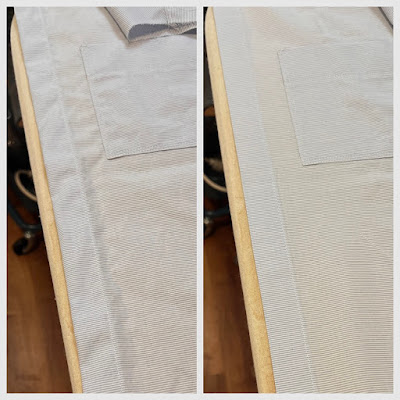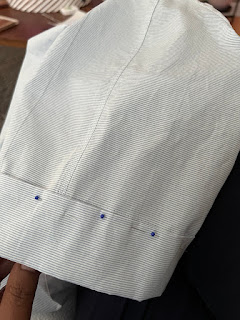The MN State Fair is apparently the second most-attended fair in the country behind Texas' state fair. It's a big deal!
I'd only been to the fair a few times, ever, and while I'd visited the Creative Activities building, and ooh'd and ahh'd over the things hanging up, I never thought I would have anything hanging in those display cases! When I joined the machine knitting group, I learned that we had many members who had won many ribbons over the years. Two years ago, I knit my best pair of socks and everyone was like, "you should enter them into the fair!" and I thought they were gassing me! HA! Well, I won a BLUE RIBBON for those socks!
Last summer, it was all house stuff, 24/7. So I didn't submit any entries. But I knew I wanted to a) submit some things this year and b) stretch myself on those projects.
Now, important to note that you can submit anything made within 3 years. But, I know I'm not going to submit something that I've been wearing regularly, so I plan to make the things I'm going to make. Registration is due a couple weeks before the drop off date so it's best to over-register and under-deliver. I registered for 6 categories this year:
- Baby 0-2
- Winter accessory (hat, mittens, gloves, etc)
- Pullover sleeveless adult sweater or vest
- Adult suit
- Pullover plain adult sweater (can include stripes)
- Pullover textured adult sweater (like tuck or lace)
I submitted to the first 4 categories. I had a cute top going for the 5th but had yarn bleed and decided to cut my losses on that project. I will finish it, because I like the top, but it wasn't going to be "right" for entry so I moved on.
I intended to make a garment for the textured category but ended up submitted that item to the sleeveless category.
1) For the baby outfit, I used a cotton yarn - three strands of very fine cotton loosely twisted together. This yarn did not want to do ANYTHING other than stockinette. It knits up beautifully though!! But tuck, garter, all those other things were out of the question with the individual strands of yarn. The machine hated it. It's a size 6 months (approximately). I never worry too much about baby outfits. If gauge is close enough, that's good enough. It's a baby. Chances are it's a very short term wear and it's more about the thoughtfulness.
I did an envelope shoulder for the first time and I DID TWO DRY-RUNS and still did the shoulder backwards. ARGH! When working on the machine, you're purl side facing, and I mixed up the directions. So that might prevent a 1st place win but maybe 2nd :) (they judge harshly! LOL!)
look at those tiny poms! (made with a fork!)
2) Next up, I intended to make a pair of fair-isle mittens and at the last minute, pivoted. I wanted vertical stripes without knitting sideways and worked out how to do it and knit a couple samples and LOVED it. Woohoo!!!! I used scraps of sock yarn that was in my stash but now I want to buy yarn for the style and make up a handful with different color schemes. A couple friends have expressed interest so they shall have them.
I'd had a few false starts with the hat and then somehow talked myself into going into the craft room at like 9:30 p.m. I then made changes to the sizing on the fly (sigh). I added 8 rows of ribbing (so another inch) and instead of knitting 10 rows of each color change (also an inch -ribbing knits up a little tighter), I went to 12 rows. Well, that 2 extra rows x 6 changes = 12 rows or a little over an inch. So now I've added 2 inches to the "height" of my hat. DOH! But it's still CUTE!
3) One of my goals this year was to start using my mid-gauge machine more. It is so handy in that the stitches are SO much larger than the standard gauge, it's easier to do some hand-manipulation...but it's a plastic bed machine and doesn't have a ribber or electronics or anything. I bought a few projects worth of DK and Worsted yarn for the purpose.
I picked up this Plymouth Yarn Sea Isle (in Lime) on a recent trip to Chicago from Wool & Co. It's a chainette pima/merino blend so it's super squishy! I thought the lace motif would really stand out in this yarn and I think I was right! Initially, I'd planned to a cable on each side of the lace but decided to let this design shine on its own.
The lace is all manipulated by hand with a transfer tool. AND I was talking to a friend while working on it! That means it's SUPER easy! lol!!! When I do short row shaping, I still have to pause my music and focus really, really hard on what I'm doing.
This photo is before I weaved in all the ends and gave it a final steam, but showing it on Lily gives a better idea of fit (though Lily is a little larger than I am so it is a loser fit)
4) The woman that sold me my machine and gave me my first few lessons was a designer and test knitter for St. John. She also designed a pant pattern to sell (cough, cough). I was determined to make the pants and bought a 1.5 pound cone of wool/rayon crepe yarn in suede from Made In America Yarns for the purpose. I'd bought a second BIG cone (that's what they call 'em) in eggplant to make a skirt and cardigan. Well, I was halfway through the top before thinking, "so interesting I bought this and I don't normally wear this color..." Well, that's because I bought it for PANTS. oy!
I created all of the garment patterns in the Knit it Now software. You start with a base pattern, input custom measurements and yarn gauge, and it creates a pattern.
I decided on this round neck, fitted top but wasn't 100% on the "right" measurements for each section. Yes, I measured myself and it all seemed fine, but it is a little longer than I'd typically wear, so that's something to keep in mind. I have a short torso and do not like to wear longer length tops for the most part.
The skirt is a straight skirt with minimal shaping on the lower half (I think the bottom hem is about 1" narrower than the hip). I used about 2 inches of negative ease in the hip and 1" positive ease in the waist. IT LOOKS SO CUTE ON! I don't have pics though (because it was nighttime and dark and I'm not wearing a bra so those will stay in the photo album!) until I get it back from the fair.
I did ribbed hems on the sweater (1" on the bottom and about 3/4" on the sleeve) and I did stockinette with picot edge for the neckband. The skirt is finished with a hung hem (essentially a fold-over hem).
It's not quite finished though (shhhhh). This yarn wants to be steamed
hard. That brings out the drape and softness, but I couldn't risk it not drying in time, so I lightly steamed after wet-blocking. But look at this pic before blocking or steaming:
steaming really brings this yarn to life!
Here is the in-progress sweater that was going to be entry #5. It wasn't until I was about to stitch down the neckband that I realized the center stripe on the front had bleed from the olive yarn. It is REALLY discolored compared to the bright white band :/
The other issue that caused me not to submit this one, with this being a sideways knit, you cast on a sleeve, knit to the body, cast on for the body, knit across, cast off the body, ,knit the sleeve, cast off the sleeve. I have done this but only on a round neck, never a v-neck.
Do you see it??
The first side has nice, fully fashioned decreases. The second side is messy by comparison. I'll ask my knitting group if there's a fix for that. I *think* I know what it is but want to verify.
And don't mind that messed up stitch in the band on the left, I will fix it when I stitch down the band :)
Now that that's done...whew! I have some SEWING to do!
I was given a whole bunch of amazing wools and silks from a knitting friend's stash and I am still sorting through it all, but have already identified 3 must-have-now garments from the fabrics. More soon :)


























